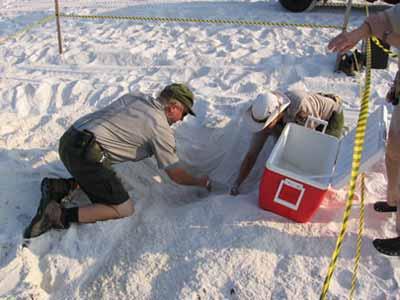Life hasn't been easy for Kemp’s Ridley sea turtles in recent years, but the ongoing impacts of the oil spill have raised new concerns for the rare animals. Biologists are moving eggs from a nest at Gulf Islands National Seashore; they will be incubated, hatched, and ultimately released into the Atlantic Ocean.
"This relocation is particularly significant because it is a Kemp's Ridley nest, the rarest of the endangered sea turtles found along the Gulf coast," said acting superintendent Nina Kelson. Since the Deepwater Horizon oil spill began, thousands of turtle eggs have been transported from sensitive lands such as national park areas and wildlife refuges, but this is the first time that a Kemp’s Ridley from Gulf Island’s National Seashore will be a part of this process.
The relocation is scheduled for today, and will involve biologists from the National Park Service, U.S. Fish and Wildlife Service and the State of Florida. The eggs will be prepared to be transported, via FedEx, to the Kennedy Space Center where they will be incubated, hatched, and ultimately released into the Atlantic Ocean.
Rick Clark, the park’s chief of science and natural resources, explains that the benefits of this unprecedented process outweigh the inherent risk of leaving them alone. There is a high probability of mortality that could result to the hatchlings because of the high concentrations of oil that are still in the Gulf of Mexico.
Kemp’s Ridleys are the smallest of the sea turtles and weigh around 100 pounds when fully grown. Hatchlings are dark grey and their shells change color as they age. They lay one to four clutches every year, containing about 100 eggs each, on sandy beaches. After 50 to 60 days, the tiny hatchlings emerge from the shell to make their way to the ocean.
Such relocation efforts entail a bit of risk, and are controversial in some quarters, but in the current circumstances, seem to offer the best shot for successful survival of this next generation of the rare turtles.




Add comment